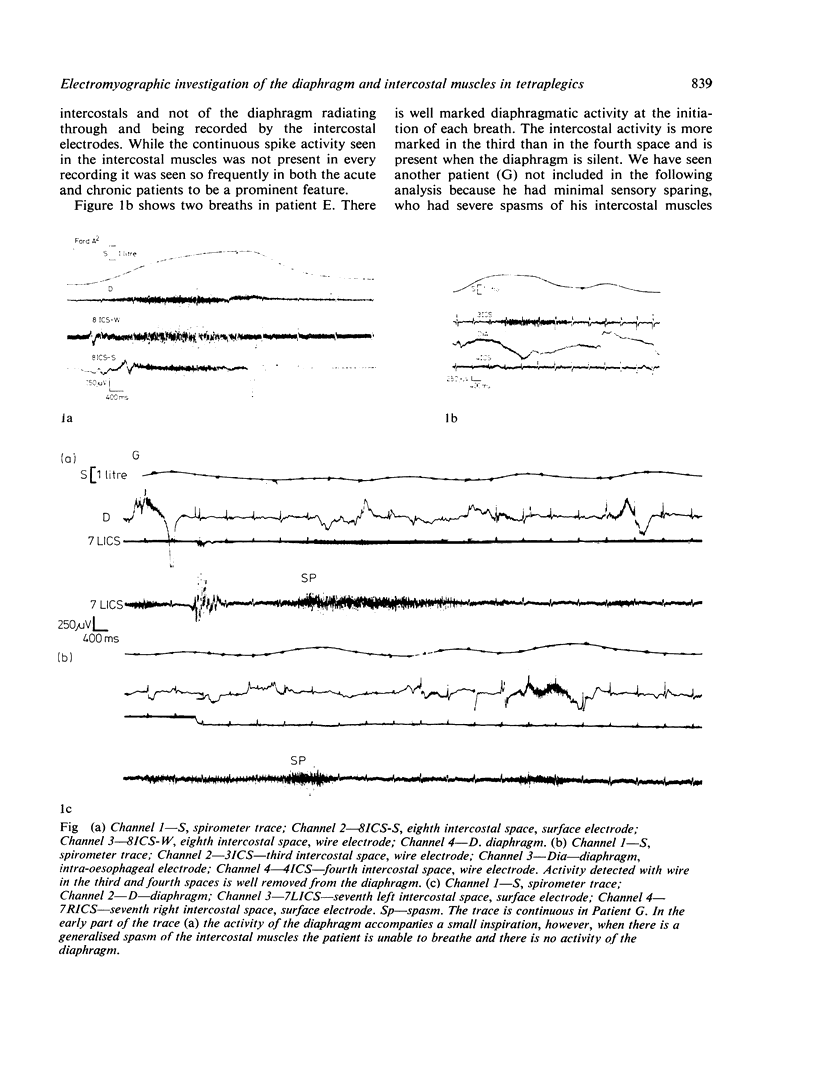Abstract
Local electromyographic activity has been demonstrated in the intercostal muscles of tetraplegic patients by using a combination of surface, fine-wire and intra-oesophageal diaphragmatic electrodes. This activity is first present and most evident in the lower chest, the point of maximum deformation in the tetraplegic's thorax. In patients with long standing injury the activity is present and prominent in the more superior intercostal muscles. We believe this activity to be reflex in character and that it develops and facilitates over time, so improving the ventilatory capacity of tetraplegics.
Full text
PDF




Selected References
These references are in PubMed. This may not be the complete list of references from this article.
- AGOSTONI E., SANT'AMBROGIO G., DEL PORTILLO CARRASCO H. Electromyography of the diaphragm in man and transdiaphragmatic pressure. J Appl Physiol. 1960 Nov;15:1093–1097. doi: 10.1152/jappl.1960.15.6.1093. [DOI] [PubMed] [Google Scholar]
- DRAPER M. H., LADEFOGED P., WHITTERIDGE D. Respiratory muscles in speech. J Speech Hear Res. 1959 Mar;2(1):16–27. doi: 10.1044/jshr.0201.16. [DOI] [PubMed] [Google Scholar]
- Davis J. N. Phrenic nerve conduction in man. J Neurol Neurosurg Psychiatry. 1967 Oct;30(5):420–426. doi: 10.1136/jnnp.30.5.420. [DOI] [PMC free article] [PubMed] [Google Scholar]
- Fugl-Meyer A. R. A model for treatment of impaired ventilatory function in tetraplegic patients. Scand J Rehabil Med. 1971;3(4):168–177. [PubMed] [Google Scholar]
- Goldman A. L., George J. Postural hypoxemia in quadriplegic patients. Neurology. 1976 Sep;26(9):815–817. doi: 10.1212/wnl.26.9.815. [DOI] [PubMed] [Google Scholar]
- Gross D., Grassino A., Ross W. R., Macklem P. T. Electromyogram pattern of diaphragmatic fatigue. J Appl Physiol Respir Environ Exerc Physiol. 1979 Jan;46(1):1–7. doi: 10.1152/jappl.1979.46.1.1. [DOI] [PubMed] [Google Scholar]
- Gross D., Ladd H. W., Riley E. J., Macklem P. T., Grassino A. The effect of training on strength and endurance of the diaphragm in quadriplegia. Am J Med. 1980 Jan;68(1):27–35. doi: 10.1016/0002-9343(80)90157-6. [DOI] [PubMed] [Google Scholar]
- Guttmann L., Silver J. R. Electromyographic studies on reflex activity of the intercostal and abdominal muscles in cervical cord lesions. Paraplegia. 1965 May;3(1):1–22. doi: 10.1038/sc.1965.1. [DOI] [PubMed] [Google Scholar]
- Leith D. E., Bradley M. Ventilatory muscle strength and endurance training. J Appl Physiol. 1976 Oct;41(4):508–516. doi: 10.1152/jappl.1976.41.4.508. [DOI] [PubMed] [Google Scholar]
- Lourenço R. V., Cherniack N. S., Malm J. R., Fishman A. P. Nervous output from the respiratory center during obstructed breathing. J Appl Physiol. 1966 Mar;21(2):527–533. doi: 10.1152/jappl.1966.21.2.527. [DOI] [PubMed] [Google Scholar]
- Miranda J. M., Lourenço R. V. Influence of diaphragm activity on the measurement of total chest compliance. J Appl Physiol. 1968 Jun;24(6):741–746. doi: 10.1152/jappl.1968.24.6.741. [DOI] [PubMed] [Google Scholar]
- Moulton A., Silver J. R. Chest movements in patients with traumatic injuries of the cervical cord. Clin Sci. 1970 Sep;39(3):407–422. doi: 10.1042/cs0390407. [DOI] [PubMed] [Google Scholar]
- PETIT J. M., MILIC-EMILI G., DELHEZ L. Role of the diaphragm in breathing in conscious normal man: an electromyographic study. J Appl Physiol. 1960 Nov;15:1101–1106. doi: 10.1152/jappl.1960.15.6.1101. [DOI] [PubMed] [Google Scholar]
- Schweitzer T. W., Fitzgerald J. W., Bowden J. A., Lynne-Davies P. Spectral analysis of human inspiratory diaphragmatic electromyograms. J Appl Physiol Respir Environ Exerc Physiol. 1979 Jan;46(1):152–165. doi: 10.1152/jappl.1979.46.1.152. [DOI] [PubMed] [Google Scholar]
- Silver J. R., Abdel-Halim R. E. Chest movements and electromyography of the intercostal muscles in tetraplegic patients. Paraplegia. 1971 Nov;9(3):123–131. doi: 10.1038/sc.1971.21. [DOI] [PubMed] [Google Scholar]
- Silver J. R., Lehr R. P. Dyspnoea during generalised spasms in tetraplegic patients. J Neurol Neurosurg Psychiatry. 1981 Sep;44(9):842–845. doi: 10.1136/jnnp.44.9.842. [DOI] [PMC free article] [PubMed] [Google Scholar]
- Silver J. R., Moulton A. The physiological and pathological sequelae of paralysis of the intercostal and abdominal muscles in tetraplegic patients. Paraplegia. 1969 Aug;7(2):131–141. doi: 10.1038/sc.1969.23. [DOI] [PubMed] [Google Scholar]
- TAYLOR A. The contribution of the intercostal muscles to the effort of respiration in man. J Physiol. 1960 May;151:390–402. doi: 10.1113/jphysiol.1960.sp006446. [DOI] [PMC free article] [PubMed] [Google Scholar]


